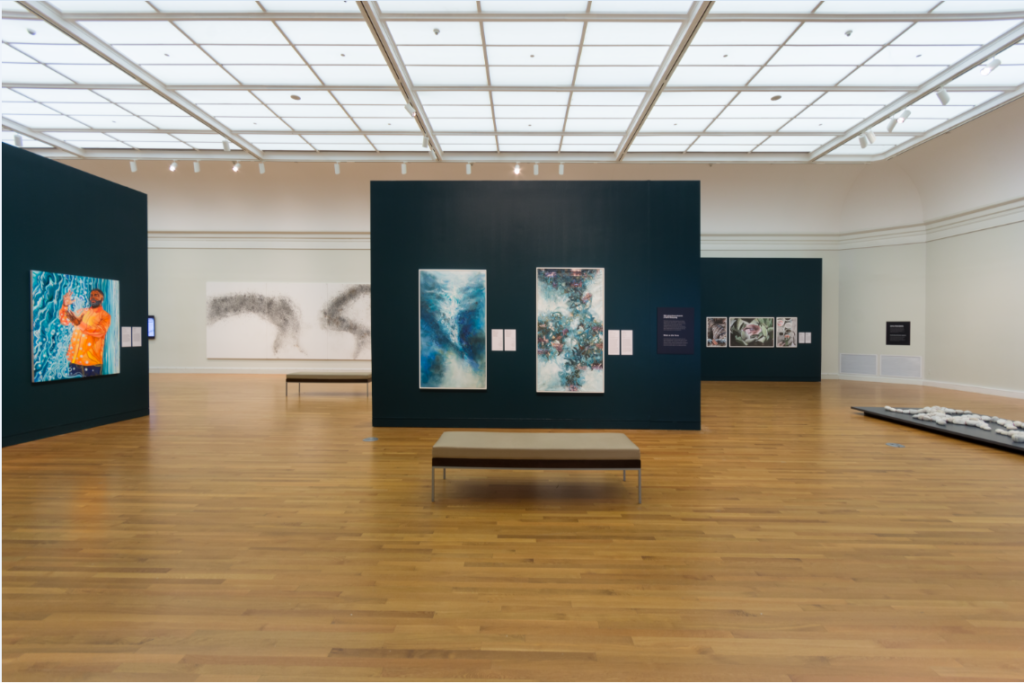The Dress of the Poem by Khaled Al’Saa’i

The Dress of the Poem by Khaled Al’Saa’i, 2020
Acrylic on canvas and Map of the Memory, 2020, acrylic and collage on canvas. Courtesy the artist © Khaled Al’Saa’i Installation photography by Charlie Edwards, courtesy of the University of Michigan Museum of Art
About the Art
Khaled Al-Saa’i
Anokii Dubai-ing, 1970 gaa-ondaadizi
Debani-ayi’iing
Minjimendamowin Inakamigad
2020
Gaaskiiginowaaboo ningaasimooniigining gaye naabinigaade
Namanji-ayi’iing
Izhi’omagad Naagadaajimowin
2020
Gaaskiiginowaaboo ningaasimooniigining
Nimiigwechiwenimaanaan Gaazheninjiged
Mishigami Gichigabegikendaasowigamig izhi-Ganawendaanaawaan Gaazheninjigaadeg waabanda’inegwaa ge Wayekwaajiwan izhiseg wenji-nanaandomangid Gaazheninjiged
Mii igo izhi-zhizhoobii’igaadewan omaa, Khaled Al-Saa’i aanikanootaanan gaa-ozhibii’igaadeg dazhindaagwag Gichigami wayekwaajiwanong – mii wenji-izhichiged – dash atood gizhibaabideg dibishkoo gizhibaajiwang. Izhi- Minjimendamowin Inakamigad (debani-ayi’iing), okaadenang mazinaakiziganan gii-mazinaakizang Gichigaming, gaa-izhi-ayaad niswaaki, gaye daso-nitami-jakibii’iganan izhi-izhinikaadeg daso gichigamiin ozhibii’igaadeg Arabic-mong. Gakina dash ogii-giizhenindaanan izhi-nisidawendaagwag gakina minjimendang iw apii bagizod Gichigaming gaye, iw apii ombigid, Euphrates ziibiing gaa-wenjibaad Mayadeen, Syria. Noongom dash apiichi miigaadiwag Syria-ing anoonji apii midaaswaaki gaye bwaa-gimiwang wenji-banaajichigaadeg, bwaa-gitigewaad gemaa bwaa-adaawewaad, gaye nandoobiiwaad moozhag.
Izhi’omagad Naagadaajimowin-ing (namanji-ayi’iing), Al Saa’i ogii-giizhenindaan gegoo izhi-nisidawendaagwag gaganoonidiwaad gaazheninjigejig ezhi-inendamowaad Gichigamiin. Wa’aw gaazheninjiged ogii-ombi’igod Keith Taylor-an gaa wenjibaanid Gaa-gaashka’aanig Oodenang ge ozhibii’aminid Gichigami miinawaa Gimiwan: Gichigami Michigan (2014) (anaami-ayi’iing) – mii dash igo gaa-ombi’igonid James Abbott McNeil Whistler-banan (1834–1903) dash gaa zhizhoobii’aminid Gichigami miinawaa Gimiwan (1865). Al-Saa’i aanikanootaan naagadaajimowin dash atood wiikwebii’igeng dash izhinikaadang “gaawitaabii’igaadeg” dash ezhi-inaagwag gakina gaa-ozhibii’ang dibishkoo digowag.
Gichigami miinawaa Gimiwan
Keith Taylor
Niimiwag jiigibiigong aabitooya’iing
zaaga’igan miinawaa nengawan
endazhi-bangishimog e-aanakwak.
Aabitooya’iing niibidebii’iganan
waabiziwang, nengawaandeg
zhiibingwaandeg bangii,
ombaaniteg biinish niimid
zaagijitakokiid zaaga’igaansing.
Mii dash gakina debwemigad.
قصيدة :كيث تيلور
ثمةَ رقصة عند حدود الماء
حركة بين البحيرة
ورمالها
والأفق
حيث تصير البحيرة سحاباً
بين تلك الأسطر عالمنا
نقعُ خفيف من ألوان باهتة
بيج و رمادي. مع ومضة من بياض
شبه مجرد، إلى أن تطأ
خطى الراقصة حوض الماء
لتجعل الكل حقيقةترجمة : رشيد اعدناني.
Syria, works in Dubai, born 1970
RIGHT
Map of the Memory
2020
Acrylic and collage on canvas
LEFT
The Dress of the Poem
2020
Acrylic on canvas
Courtesy of the artist
Commissioned by the University of Michigan Museum of Art for Watershed
In these two paintings, Khaled Al-Saa’i translates texts about the Great Lakes watershed—a source of inspiration for his practice—into a swirling sea of calligraphic forms that suggest the movement and experience of water. In Map of the Memory (right), he interweaves photographs of the Great Lakes region, where he spent three years, with the first letters of the names of each Great Lake rendered in Arabic. His combination of image and text evokes his joyful memories of swimming in both the Great Lakes and, as a child, in the once-mighty Euphrates River in his hometown of Mayadeen, Syria. Now severely affected by drought, Syria is experiencing water scarcity that has curtailed agricultural production and caused economic instability, further exacerbating the effects of more than a decade of civil war.
In The Dress of the Poem (left), Al-Saa’i creates a dynamic conversation between artists representing the Great Lakes. The painting is inspired by Ann Arbor-based poet Keith Taylor’s Sea and Rain: Lake Michigan (2014) (below)—which was, in turn, inspired by UMMA’s painting Sea and Rain (1865) by American artist James Abbott McNeil Whistler (1834–1903). Al-Saa’i translates the poem into fluid calligraphic forms, creating what he calls a “universe of words” in which the lines of poetry depict a lake’s waves.
Sea and Rain: Lake Michigan
Keith Taylor
There is a dance at water’s edge,
a movement between the lake, its sand
and the horizon where lake becomes cloud.
Between those lines our world’s
a thin wash of muted tones, beige
and gray with a hint of white,
almost abstract, until the dancer
steps out into the pool.
She makes the whole thing real.
قصيدة :كيث تيلور
ثمةَ رقصة عند حدود الماء
حركة بين البحيرة
ورمالها
والأفق
حيث تصير البحيرة سحاباً
بين تلك الأسطر عالمنا
نقعُ خفيف من ألوان باهتة
بيج و رمادي. مع ومضة من بياض
شبه مجرد، إلى أن تطأ
خطى الراقصة حوض الماء
لتجعل الكل حقيقةترجمة : رشيد اعدناني.
Translated by Rachid Aadnani
